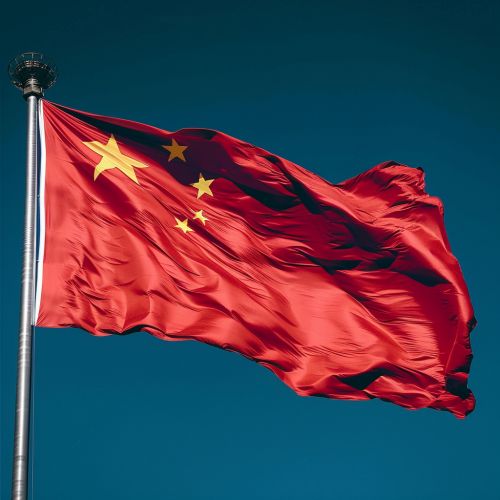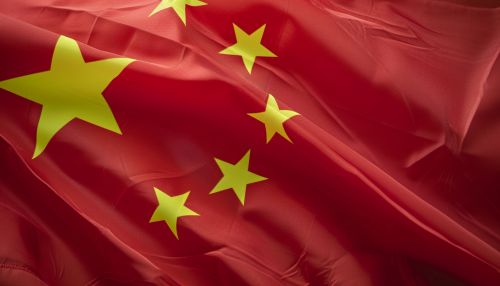Flag of China: Difference between revisions
(Created page with "== Design and Symbolism == The flag of China, officially known as the Five-star Red Flag, is a prominent symbol of the People's Republic of China (PRC). The flag features a red field with five golden stars in the top left corner. The red color symbolizes the communist revolution and the blood of those who died during the civil war and the Japanese invasion. The five stars and their relationship represent the unity of the Chinese people under the leadership of the Co...") |
No edit summary |
||
| Line 3: | Line 3: | ||
The flag of China, officially known as the [[Five-star Red Flag]], is a prominent symbol of the People's Republic of China (PRC). The flag features a red field with five golden stars in the top left corner. The red color symbolizes the communist revolution and the blood of those who died during the civil war and the Japanese invasion. The five stars and their relationship represent the unity of the Chinese people under the leadership of the Communist Party of China (CPC). The larger star symbolizes the CPC, while the four smaller stars represent the four social classes as defined by Mao Zedong: the working class, the peasantry, the urban petite bourgeoisie, and the national bourgeoisie. | The flag of China, officially known as the [[Five-star Red Flag]], is a prominent symbol of the People's Republic of China (PRC). The flag features a red field with five golden stars in the top left corner. The red color symbolizes the communist revolution and the blood of those who died during the civil war and the Japanese invasion. The five stars and their relationship represent the unity of the Chinese people under the leadership of the Communist Party of China (CPC). The larger star symbolizes the CPC, while the four smaller stars represent the four social classes as defined by Mao Zedong: the working class, the peasantry, the urban petite bourgeoisie, and the national bourgeoisie. | ||
[[Image:Detail-91765.jpg|thumb|center|The national flag of China, featuring a red field with five yellow stars in the top left corner.|class=only_on_mobile]] | |||
[[Image:Detail-91766.jpg|thumb|center|The national flag of China, featuring a red field with five yellow stars in the top left corner.|class=only_on_desktop]] | |||
== Historical Background == | == Historical Background == | ||
Latest revision as of 18:21, 19 June 2024
Design and Symbolism
The flag of China, officially known as the Five-star Red Flag, is a prominent symbol of the People's Republic of China (PRC). The flag features a red field with five golden stars in the top left corner. The red color symbolizes the communist revolution and the blood of those who died during the civil war and the Japanese invasion. The five stars and their relationship represent the unity of the Chinese people under the leadership of the Communist Party of China (CPC). The larger star symbolizes the CPC, while the four smaller stars represent the four social classes as defined by Mao Zedong: the working class, the peasantry, the urban petite bourgeoisie, and the national bourgeoisie.


Historical Background
Early Flags
Before the establishment of the PRC, various flags were used in China. During the Qing Dynasty, the flag was a dragon on a yellow field. The Republic of China (ROC), established in 1912, initially used the "Five-Colored Flag" representing the five major ethnic groups: Han, Manchu, Mongol, Hui, and Tibetan. Later, the ROC adopted the "Blue Sky with a White Sun" flag.
Creation of the Current Flag
The current flag was designed by Zeng Liansong, an economist and talented artist. In July 1949, the Preparatory Committee of the New Political Consultative Conference (NPCC) announced a public competition to design the national flag. Zeng's design was selected from nearly 3,000 entries. The design was officially adopted on September 27, 1949, during the First Plenary Session of the Chinese People's Political Consultative Conference (CPPCC).
Flag Specifications
The flag's dimensions and proportions are strictly regulated. The flag's aspect ratio is 2:3, meaning it is two units high and three units wide. The larger star has a diameter of 30% of the flag's height, while the smaller stars have a diameter of 10% of the flag's height. The stars are positioned in a specific arrangement, with the larger star centered at one-quarter of the flag's height and one-quarter of the flag's width from the top left corner. The smaller stars are arranged in an arc to the right of the larger star, each pointing towards the center of the larger star.
Symbolism and Interpretation
The flag's design and colors are rich in symbolism. The red background represents the communist revolution and the blood of the martyrs who sacrificed their lives for the nation's liberation. The five stars and their relationship symbolize the unity of the Chinese people under the leadership of the Communist Party. The larger star represents the Communist Party, while the four smaller stars represent the four social classes as defined by Mao Zedong: the working class, the peasantry, the urban petite bourgeoisie, and the national bourgeoisie. This arrangement signifies the importance of the Communist Party's leadership and the unity of the people in building a socialist nation.
Usage and Protocol
The flag of China is used in various official capacities and is subject to strict protocols. It is flown daily at Tiananmen Square in Beijing, the seat of the Chinese government. The flag is also flown at Chinese embassies and consulates worldwide, as well as at official government buildings, schools, and other public institutions within China.
Flag Raising and Lowering
The flag is raised at sunrise and lowered at sunset. During the flag-raising ceremony, the national anthem, the "March of the Volunteers," is played. The flag must be raised briskly and lowered slowly and ceremoniously. When flown at half-mast, the flag is first raised to the top of the pole before being lowered to the halfway point. It is then raised to the top of the pole again before being fully lowered at the end of the day.
Displaying the Flag
The flag must be displayed in a prominent position, often higher than other flags. When displayed with other flags, the national flag should be in the center and at the highest point. When displayed indoors, the flag should be placed to the right of the speaker or stage. The flag must not be allowed to touch the ground and should be handled with respect at all times.
Variations and Derivatives
The design of the national flag has inspired several derivative flags used by various administrative divisions and organizations within China. For example, the flags of the Hong Kong Special Administrative Region and the Macau Special Administrative Region incorporate elements of the national flag while also reflecting local characteristics. The flag of the People's Liberation Army (PLA) also features a red field with a golden star, along with the characters "八一" (August 1), commemorating the founding date of the PLA.
Controversies and Criticisms
The flag of China has been the subject of various controversies and criticisms, both domestically and internationally. Some critics argue that the flag's design and symbolism are too closely associated with the Communist Party and do not adequately represent the diversity of the Chinese population. Others have raised concerns about the flag's use in promoting nationalistic and political agendas. Despite these criticisms, the flag remains a powerful symbol of national identity and pride for many Chinese people.
